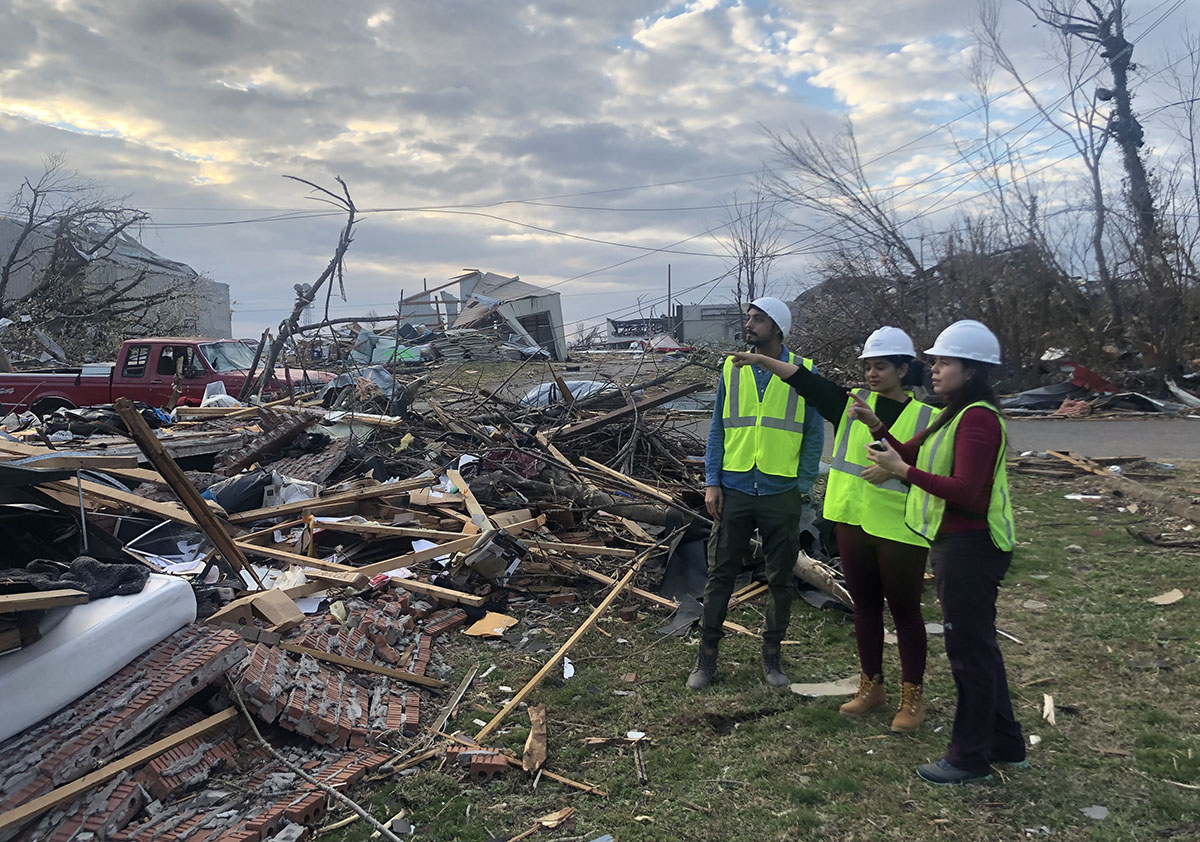
Rakeh Saleem and Saanchi Kaushal, both architectural engineering doctoral students, and Rebecca Napolitano, assistant professor of architectural engineering, evaluate the damage of buildings in the aftermath of the tornadoes. Credit: Mariantonieta Gutierrez Soto
Engineers assess structural damage and resilience after Kentucky tornado
2/7/2022
By Sarah Small
MAYFIELD, KY — Sometimes research means combing through data on a computer or studying a sample in a quiet lab. Other times, it means taking an unplanned, 12-hour road trip to don a hardhat and collect the data yourself. Faculty members and graduate students from the Penn State College of Engineering did the latter, traveling to Mayfield, Kentucky, to capture data on tornado destruction in the wake of the December 2021 Midwest Tornado series.
As members of the Field Assessment Structural Team, known as FAST, within national Structural Extreme Events Reconnaissance (StEER) Network, Mariantonieta Gutierrez Soto, assistant professor in the School of Engineering Design, Technology, and Professional Programs and global engineering design engagement coordinator, and Rebecca Napolitano, assistant professor of architectural engineering, are notified by StEER when there is a need to deploy researchers to document damage immediately after a natural disaster.
“This trip was a recon mission,” Napolitano said. “We needed to capture some of the data that wouldn’t be there two weeks later due to cleanup. We did a door-to-door assessment, got a street view with a camera on the car and used a drone for aerial evaluation.”
In addition to documenting the built environment with photographs, the two researchers and their graduate students, Saanchi Singh Kaushal and Rakeh Saleem, assessed damage using standard language and observation metrics, as agreed-upon by StEER. For example, in assessing damage to a roof, the researchers used a wind damage rating that differentiates between half of the roof being attached still, one third of it attached, and so on. They also included information that can only be determined by immediate, on-the ground observation, such as damage that they can tell was caused by a tree or by litter, since — before clean-up efforts — they can still see the trees and litter in the area.

From left to right: Architectural engineering doctoral students Rakeh Saleem and Saanchi Kaushal and SEDTAPP Assistant Professor Mariantonieta Gutierrez Soto assess damage to structures after the December 2021 tornadoes in Kentucky.
Their data was compiled with information collected by other network members at various universities in the StEER 2021 Midwest Tornado Outbreak Joint Preliminary Virtual Reconnaissance Report and Early Access Reconnaissance Report. The report summarizes the performance of various structures and recommends research paths for developing disaster-resilient structures.
Napolitano and Gutierrez Soto will use the data to inform their research on the resiliency of older structural features for potential contemporary use and the structural engineering aspect of community recovery after disasters, respectively.
“How resilient is the entire community? How fast is the community recovering?” Gutierrez Soto asked. “Every state has a management plan after natural disasters. We’re tapping into that space to understand how different communities prepare differently and how we can design so everyone can better prepare with monitoring tools and more.”
The researchers plan to revisit Mayfield over the next few months to continue assessing the community’s recovery.
MEDIA CONTACT:
College of Engineering Media Relations
communications@engr.psu.edu



